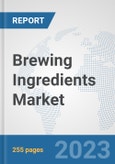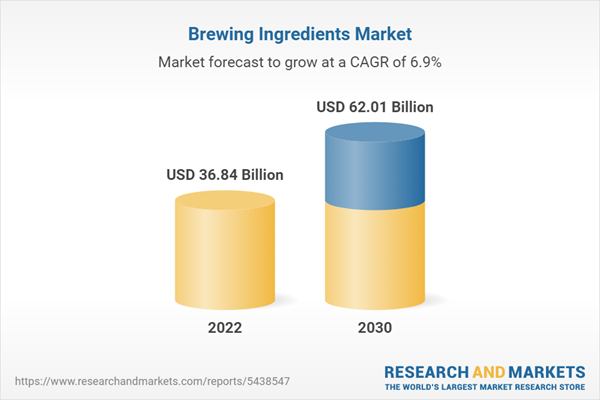The report on the global brewing ingredients market provides qualitative and quantitative analysis for the period from 2021-2030. The revenue generated by the market was USD 36844.12 Million in 2022 and is expected to reach USD 62012.53 Million in 2030, with a CAGR of 6.87% till 2030 during the projected period. The study on brewing ingredients market covers the analysis of the leading geographies such as North America, Europe, Asia Pacific, and RoW for the period of 2021-2030.
Beer, an ancient and extensively consumed fermented beverage holds the distinction of being one of the most intricate among craft drinks. Crafted from cereal grains, its characteristics such as flavor, color, mouthfeel, and potency exhibit an unparalleled range of variations. The global brewing ingredients market is being propelled by the increasing consumption of beer. Over the past few years, there has been a notable surge in the consumption of beer-related products, primarily driven by the rise in disposable income among both new and middle-class consumers. These consumer segments, characterized by their mobility and willingness to explore diverse culinary experiences, have contributed significantly to the growth of beer consumption. Moreover, the influence of Western and corporate culture has played a pivotal role in expanding this market in developing economies.
Malt extract brewing refers to a method of brewing beer that utilizes malt extract as the primary source of fermentable sugars. Malt extract is a concentrated form of malted grains, typically barley, that has been processed to extract the sugars and other soluble components from the grains. This extract is available in liquid or dry form and is used as a substitute for traditional mashing and lautering processes involved in all-grain brewing. In malt extract brewing, the malt extract is dissolved in water to create the wort, which serves as the foundation for the beer. This eliminates the need for mashing and extracting sugars from whole grains. The malt extract already contains the necessary enzymes for converting starches into fermentable sugars, making the brewing process more accessible and time-efficient for homebrewers or those with limited brewing equipment.
The Europe region is witnessing a growing demand for brewing ingredients, driven by various factors. One of the key drivers is the increasing popularity of craft beer and the rise of microbreweries. Craft beer enthusiasts are seeking unique and diverse flavors, prompting brewers to experiment with different ingredients to create innovative brews. This has fueled the demand for a wide range of brewing ingredients, including malt, hops, yeast, and specialty grains. Additionally, the growing consumer preference for locally brewed and artisanal beers has contributed to the demand for brewing ingredients. Consumers are increasingly conscious of the origin and quality of their beverages, leading to a higher demand for locally sourced ingredients that can enhance the flavor and character of the beer.
1. Key Opinion Leaders
2. Internal and External subject matter experts
3. Professionals and participants from the industry
2. Product/brand/marketing managers
3. CXO level executives
4. Regional/zonal/country managers
5. Vice President level executives.
2. Government/institutional publications
3. Trade and associations journals
4. Databases such as WTO, OECD, World Bank, and among others.
5. Websites and publications by research agencies
2. Complete coverage of all the segments in the brewing ingredients market to analyze the trends, developments in the global market and forecast of market size up to 2030.
3. Comprehensive analysis of the companies operating in the global brewing ingredients market. The company profile includes analysis of product portfolio, revenue, SWOT analysis and latest developments of the company.
4. Growth Matrix presents an analysis of the product segments and geographies that market players should focus to invest, consolidate, expand and/or diversify.
Beer, an ancient and extensively consumed fermented beverage holds the distinction of being one of the most intricate among craft drinks. Crafted from cereal grains, its characteristics such as flavor, color, mouthfeel, and potency exhibit an unparalleled range of variations. The global brewing ingredients market is being propelled by the increasing consumption of beer. Over the past few years, there has been a notable surge in the consumption of beer-related products, primarily driven by the rise in disposable income among both new and middle-class consumers. These consumer segments, characterized by their mobility and willingness to explore diverse culinary experiences, have contributed significantly to the growth of beer consumption. Moreover, the influence of Western and corporate culture has played a pivotal role in expanding this market in developing economies.
Malt extract brewing refers to a method of brewing beer that utilizes malt extract as the primary source of fermentable sugars. Malt extract is a concentrated form of malted grains, typically barley, that has been processed to extract the sugars and other soluble components from the grains. This extract is available in liquid or dry form and is used as a substitute for traditional mashing and lautering processes involved in all-grain brewing. In malt extract brewing, the malt extract is dissolved in water to create the wort, which serves as the foundation for the beer. This eliminates the need for mashing and extracting sugars from whole grains. The malt extract already contains the necessary enzymes for converting starches into fermentable sugars, making the brewing process more accessible and time-efficient for homebrewers or those with limited brewing equipment.
The Europe region is witnessing a growing demand for brewing ingredients, driven by various factors. One of the key drivers is the increasing popularity of craft beer and the rise of microbreweries. Craft beer enthusiasts are seeking unique and diverse flavors, prompting brewers to experiment with different ingredients to create innovative brews. This has fueled the demand for a wide range of brewing ingredients, including malt, hops, yeast, and specialty grains. Additionally, the growing consumer preference for locally brewed and artisanal beers has contributed to the demand for brewing ingredients. Consumers are increasingly conscious of the origin and quality of their beverages, leading to a higher demand for locally sourced ingredients that can enhance the flavor and character of the beer.
Report Findings
1) Drivers
- Rising beer consumption among the population is primarily driving the growth of the brewing ingredients market.
- The influence of western and corporate culture is propelling the growth of the market in developing economies.
2) Restraints
- The stringent regulations on the beer industry are restraining market growth.
3) Opportunities
- The introduction of new flavors by producers is anticipated to provide opportunities to the market players.
Research Methodology
A) Primary Research
The primary research involves extensive interviews and analysis of the opinions provided by the primary respondents. The primary research starts with identifying and approaching the primary respondents, the primary respondents are approached include1. Key Opinion Leaders
2. Internal and External subject matter experts
3. Professionals and participants from the industry
The primary research respondents typically include
1. Executives working with leading companies in the market under review2. Product/brand/marketing managers
3. CXO level executives
4. Regional/zonal/country managers
5. Vice President level executives.
B) Secondary Research
Secondary research involves extensive exploring through the secondary sources of information available in both the public domain and paid sources. Each research study is based on over 500 hours of secondary research accompanied by primary research. The information obtained through the secondary sources is validated through the crosscheck on various data sources.The secondary sources of the data typically include
1. Company reports and publications2. Government/institutional publications
3. Trade and associations journals
4. Databases such as WTO, OECD, World Bank, and among others.
5. Websites and publications by research agencies
Segment Covered
The global brewing ingredients market is segmented on the basis of product type, function type, and end user.The Global Brewing Ingredients Market by Product Type
- Malt Extract
- Grains
- Yeasts
- Beer Additives
The Global Brewing Ingredients Market by Function Type
- Fragrance
- Preservatives
- Flavors
- Proteins
- Others
The Global Brewing Ingredients Market by End User
- Microbreweries
- Brewpubs
- Contract Brewery
- Craft Brewers
Company Profiles
The companies covered in the report include- Lallemand Inc.
- Viking Malt
- Lesaffre
- Maltexco S.A.
- Simpsons Malt
- BOORTMALT
- Briess Malt & Ingredients
- AngelYeast Co., Ltd.
- Malteurop
- Rahr Corporation
What does this Report Deliver?
1. Comprehensive analysis of the global as well as regional markets of the brewing ingredients market.2. Complete coverage of all the segments in the brewing ingredients market to analyze the trends, developments in the global market and forecast of market size up to 2030.
3. Comprehensive analysis of the companies operating in the global brewing ingredients market. The company profile includes analysis of product portfolio, revenue, SWOT analysis and latest developments of the company.
4. Growth Matrix presents an analysis of the product segments and geographies that market players should focus to invest, consolidate, expand and/or diversify.
This product will be delivered within 1-3 business days.
Table of Contents
Chapter 1. Preface
Chapter 2. Executive Summary
Chapter 3. Global Brewing Ingredients Market Overview
Chapter 5. Global Brewing Ingredients Market by Product Type
Chapter 6. Global Brewing Ingredients Market by Function Type
Chapter 7. Global Brewing Ingredients Market by End User
Chapter 8. Global Brewing Ingredients Market by Region 2023-2030
Chapter 9. Company Profiles and Competitive Landscape
Companies Mentioned
- Lallemand Inc.
- Viking Malt
- Lesaffre
- Maltexco S.A.
- Simpsons Malt
- BOORTMALT
- Briess Malt & Ingredients
- AngelYeast Co., Ltd.
- Malteurop
- Rahr Corporation
Table Information
| Report Attribute | Details |
|---|---|
| No. of Pages | 255 |
| Published | July 2023 |
| Forecast Period | 2022 - 2030 |
| Estimated Market Value ( USD | $ 36.84 Billion |
| Forecasted Market Value ( USD | $ 62.01 Billion |
| Compound Annual Growth Rate | 6.8% |
| Regions Covered | Global |
| No. of Companies Mentioned | 10 |









